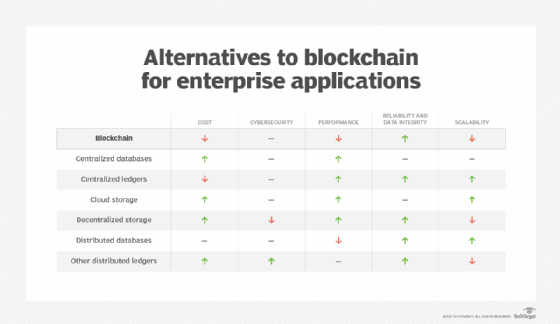6 alternatives to blockchain for businesses to consider
Technologies like cloud storage and distributed databases provide some of blockchain's data-integrity and reliability advantages with fewer performance, efficiency and cost issues.
Blockchain has risen to prominence thanks to enthusiasm about cryptocurrencies such as Bitcoin, Ethereum and Dogecoin. Businesses have also taken note of the promise of blockchain technology to improve the transparency and data integrity of distributed transactions.
However, despite the promise, blockchain adoption beyond proof of concept has been slow. One big issue has been the relatively slow performance of early blockchain technologies. The first blockchain networks were limited to a few transactions per second and could take up to an hour to guarantee the authenticity of transactions.
Several alternatives to blockchain that provide better performance have emerged. Businesses might also want to consider them to reduce costs, simplify development and reduce integration challenges.
But asking about alternatives to blockchain is somewhat backward, according to Derek Brink, vice president and research fellow at Aberdeen Strategy & Research, a technology advisory firm. That's because in many cases blockchain is the alternative. The real issue, he said, is finding new ways to reinvent business processes by disintermediating the middleman regardless of whether blockchain, strictly speaking, is the means. Indeed some of the most promising alternatives to blockchain will include centralized databases, decentralized storage and other technologies that use the same distributed ledger technology as blockchain, Brink said.

Is it blockchain or isn't it?
Fundamentally, blockchain is a type of distributed ledger designed to provide a permanent, tamper-proof record of business transactions. It's essentially a decentralized database that runs on a peer-to-peer network, with each computer maintaining a copy of the current ledger. Data security and reliability are the main benefits, since the data can't be easily changed and the redundant copies make data loss unlikely. You don't need a middleman, such as a bank or broker, to execute transactions.
One of the challenges in finding alternatives to blockchain is knowing which products and technologies use blockchain and which ones use other technologies to perform similar functions.
 Brian Platz
Brian Platz
"Blockchain has become sort of like Kleenex, where it means a category of things," said Brian Platz, co-CEO of Fluree, a blockchain database provider. "Other technologies that are not even distributed ledgers all get thrown into the mix and are also called blockchains."
For example, people in the blockchain community have begun adopting distributed storage tools like Storj and InterPlanetary File System (IPFS). Others are starting to take advantage of distributed databases such as OrbitDB. In addition, a wide variety of distributed ledgers are starting to emerge.
At the same time, good, old-fashioned centralized ledgers have been working just fine for years, and now the cloud makes it easier to share access across trusted users.
Here's what the six main alternatives to blockchain have to offer.
1. Centralized databases
One of the biggest concerns about traditional blockchains has been scalability.
Decentralization by its very nature adds overhead for maintaining multiple copies of the data and ensuring consistency. Blockchains also add significant computational needs and energy consumption problems.
While the blockchain community gets excited about decentralizing the database, there is real value in managing one highly optimized system of record in a centralized database.
Newer blockchain implementations are getting better, but their performance still pales in comparison to what is possible with a well-managed centralized database. For example, the Visa network (VisaNet) has a capacity of 65,000 transactions per second, whereas the Bitcoin network can only handle a few transactions per second. VisaNet currently handles an average of 2,000 transactions per second, so there is plenty of room for growth.
One of the big promises of blockchain has been the potential for improving security. But the success of VisaNet suggests that businesses could continue to successfully use alternatives to blockchain for things like securing transactions, improving product tracking, facilitating product recalls, protecting privacy and maintaining audit trails.
2. Centralized ledgers
Few companies have the resources to replicate VisaNet. Another option is the centralized ledgers that cloud providers have started offering.
 Alex-Paul Manders
Alex-Paul Manders
For example, Amazon's Quantum Ledger Database simplifies the process of implementing a shared database designed for ledger-like applications that provides a cryptographically verifiable audit trail without all the overhead of a distributed ledger or blockchain. It promises the immutability and verifiability of blockchain combined with the ease and scalability of a traditional cloud service. Amazon cautions, however, that a proper blockchain might be a better option in cases that involve untrusted parties.
Centralized databases and ledgers aren't all upside, however. Both have points of failure that are prone to cybersecurity hacks and data breaches, said Alex-Paul Manders, partner at ISG, a technology research and advisory firm.
3. Distributed databases
Major database vendors such as Oracle and Microsoft have offered distributed databases for years that use some combination of data replication and duplication to ensure data consistency and integrity.
More recently, the OrbitDB open source project emerged to support the creation of a distributed, peer-to-peer database that operates without a traditional blockchain. This allows companies to develop decentralized applications that run when disconnected from the internet and then sync up with other database nodes when connected. It can also allow data sharing in a way that enforces privacy and provides transparency into how data is being used. OrbitDB sits on top of a distributed filesystem that allows operation even if one node goes down -- another blockchain-like feature.
4. Cloud storage
Blockchain is sometimes promoted as a way to store data in a decentralized manner. But blockchain storage comes at a high cost.
 Suseel Menon
Suseel Menon
Suseel Menon, practice director at Everest Group, said the trust and security policies and governance layers of cloud services are sufficient for most enterprise applications. In addition, several third-party data storage services can provide better governance and security with far less overhead than a blockchain would entail, he said.
5. Decentralized storage
IPFS has emerged as a promising approach for storing data across a peer-to-peer network. Platz, of Fluree, said it is attracting a lot of interest from blockchain developers because of its ability to decentralize storage that can be integrated into other applications. It is not technically a blockchain, although Platz sometimes hears it referred to as one. IPFS allows developers to store webpages, content and data in ways that can reduce bandwidth requirements, improve resilience and mitigate the impact of censorship.
Storj is another promising distributed storage technology that allows developers to encrypt files, split them into pieces and then distribute them across a global cloud network. It is directly compatible with Amazon S3 storage tools, which should make it easy for cloud developers to weave into applications without learning new tools.
6. Other distributed ledger technologies
ISG's Manders said a distributed ledger would be his recommended blockchain alternative for trusted decentralized applications. He does not see a particular need to build a decentralized ledger from the ground up and recommends using one of the several options already available. Attractive alternatives to blockchain for distributed ledgers include Hashgraph, Iota Tangle and R3 Corda.
Both Iota and Hashgraph use Directed Acyclic Graphs (DAGs) as an alternative data structure for maintaining the ledger. DAGs have been commonly used in computer languages for more than 30 years for representing the dependencies in an application and there is nothing inherently unique about applying them to transactions.
One of the main benefits of the DAG approach is that it allows an application to write data quickly, but it has a relatively longer time before the transaction can be confirmed compared to private blockchains, which require permission to conduct certain operations. The applications need to be configured to notify users when conflicts occur, and rules are often built into the protocol to help resolve these issues.
Iota Tangle
An Iota Tangle stores data across a DAG in which each node, or vertex, represents a transaction. It is an open source project in which the network grows via transactions rather than through a compute-intensive mining process like blockchain uses. Iota supports micropayments and transactions across IoT devices. Although it is mostly decentralized, it does require a coordinator node that oversees and confirms the addition of new transactions.
Hashgraph
Hashgraph is another DAG ledger that also eliminates the need for mining to grow the ledger. It works on top of a protocol called gossip about gossip that network nodes use to share information, come to consensus (another key process in blockchain) and add new transactions to the DAG. As new data is added, an audit trail is also appended to the distributed ledger. Adoption of the blockchain alternative started out slow, but momentum is growing.
R3 Corda
Corda was developed to make it easier to record and process financial transactions. It uses a peer-to-peer model in which each peer stores data that relates to all the transactions it has participated in. Consequently, re-creating an audit trail requires querying multiple nodes involved in a chain of transactions. This approach can secure data about transactions by securing the appropriate set of peers. One difference between Corda and the other two is that it simplifies the creation, automation and enforcement of smart contracts -- a key application of blockchain -- compared to DAG-based distributed ledger technologies. However, the Iota Foundation just announced an alpha version of the Iota Smart Contracts Protocol, which could provide functions similar to Corda's.







